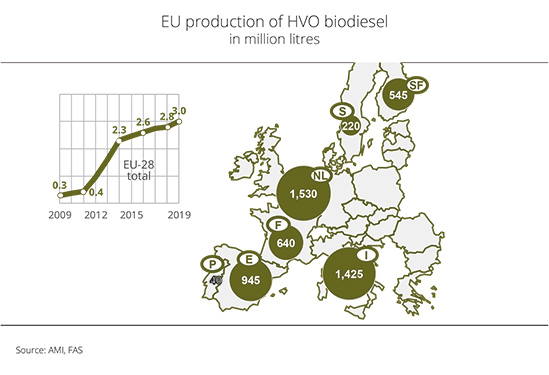
Production of hydrogenated vegetable oil (HVO) in the European Union has picked up pace since 2012. Mineral oil groups, such as Neste, Eni and Total, were the main entities promoting the creation of corresponding capacities. From the perspective of the Union zur Förderung von Oel- und Proteinpflanzen (UFOP), the key reason for the development is that the iLUC Regulation introduced in 2015 permits that biofuels from waste oils and fats can be counted double. At the same time, pressure on prices has increased in the international vegetable oil markets.
Palm oil has become cheaper and cheaper relative to soybean and, above all, rapeseed oil. Plant operators can order the feedstock flexibly, depending on price. However, the mineral oil group Total underestimated the opposition from French farmers in June 2018. The farmers staged a massive protest against Total’s plans to initially use approximately 0.5 million tonnes of palm oil as a feedstock at La Mede. This translates to about 0.14 million hectares of additional palm oil plantations.
HVO plants can use a wide range of feedstocks, such as native vegetable oil, animal fats, fish oil, and used cooking oil as well as oils that are by-products of different industrial processes, such as tall oil from the wood and paper industries, palm oil mill effluent and palm fatty acid distillate (PFAD). In view of these feedstock options, UFOP has urged the EU to step up certification and documentation requirements.
HVO output in the EU is estimated at 2.8 billion litres in 2018 and expected to rise slightly to 3 billion litres in 2019. The planned production facilities in France and Italy are expected to boost production to 3.5 and 4.5 billion litres respectively from 2020 onwards. These volumes are major factors in making the EU the largest producer of alternative diesel fuels in the world. According to information published by Agrarmarkt Informations-Gesellschaft mbH (AMI), production of biodiesel including HVO in 2019 will amount to around 14.2 billion litres.
HVO is made by saturating the double bonds in the fatty acid molecules of vegetable and animal oils and fats with hydrogen. Propane is produced as a by-product. The product can be modified in the HVO production process, so that HVO can be blended with fossil fuels at 7 per cent (the same as biodiesel) or more to make regenerative diesel or biokerosene. This means that HVO can be incorporated specifically and irrespective of the time of year (winter quality) for existing vehicle fleets in the carriage of goods or in traditional kerosene. Contrary to fatty acid methyl ester production (biodiesel), this method involves very high investment costs.
Along with the option of double counting and superior GHG reduction values compared to conventional biodiesel from vegetable oils, the feedstock price is key to the preference of using HVO. UFOP has noted that the European biodiesel industry is challenged to accept this competition for GHG efficiency and further improvement of product quality as a prerequisite to ensure its future competitiveness. UFOP supports, within the scope of its resources, research projects on biodiesel and rapeseed oil fuels (https://www.ufop.de/biodiesel-und-co/biodiesel/forschung-und-entwicklung/).
Source
Supplier
Eni S.p.A.
European Union
Neste Corporation
Total
Union zur Förderung von Oel- und Proteinpflanzen e.V. (UFOP)
Share
Renewable Carbon News – Daily Newsletter
Subscribe to our daily email newsletter – the world's leading newsletter on renewable materials and chemicals










